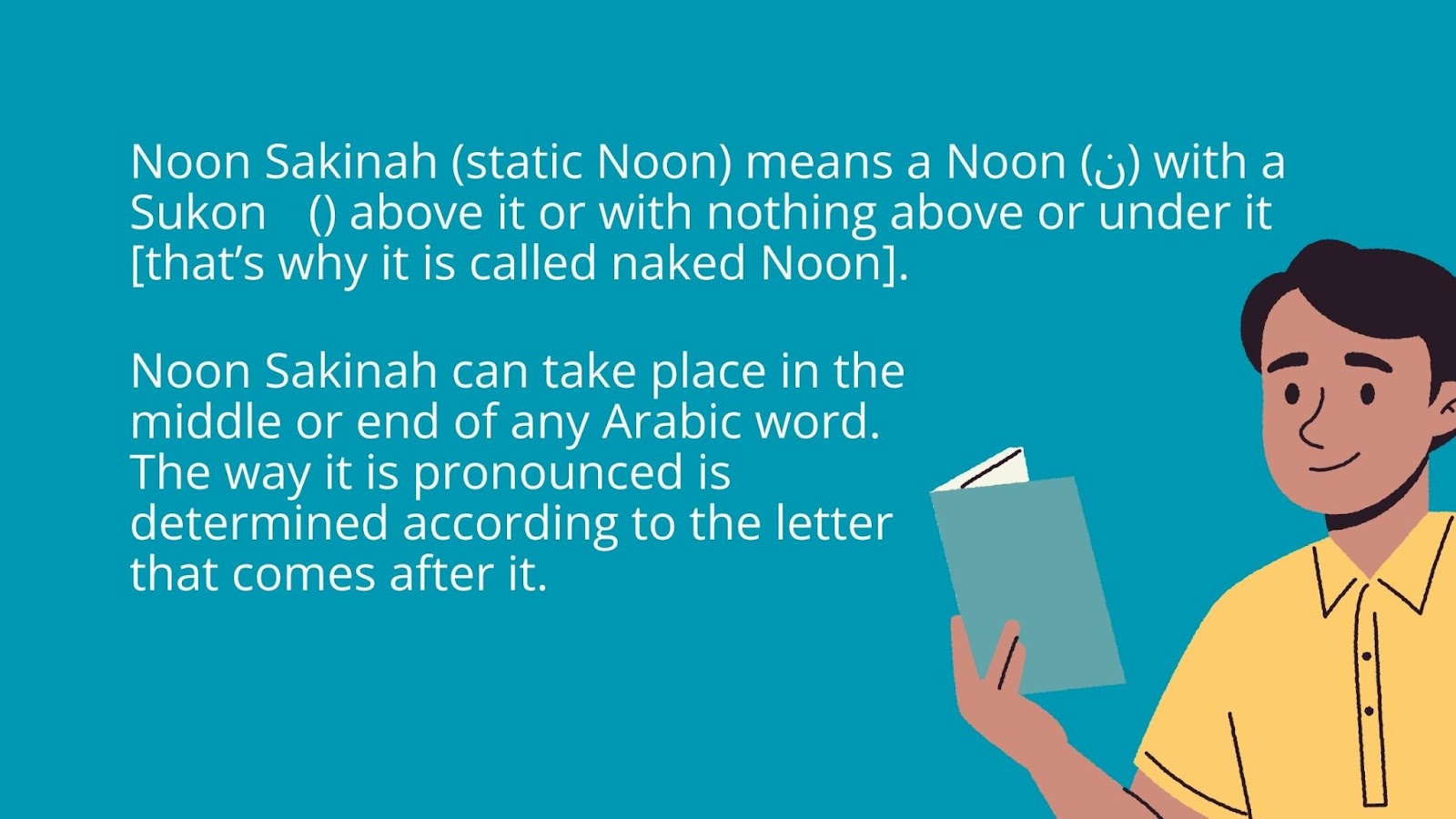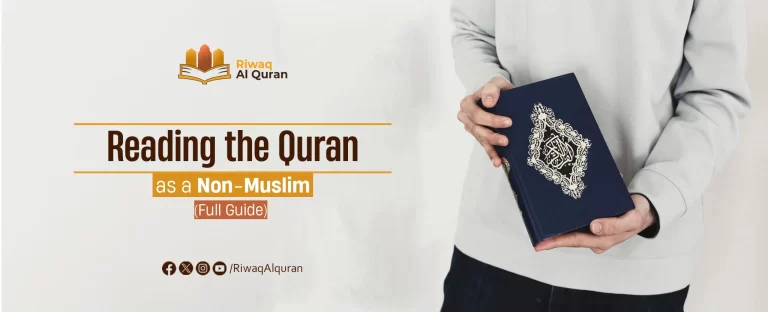Ikhfa, Idgham, Izhar, and Iqlab are four linguistic phenomena in Arabic phonology that are essential to understanding the pronunciation of Arabic words, as they involve the assimilation or deletion of sounds based on specific conditions. Although these four concepts apply to all spoken Arabic languages, they have a special significance in reciting the Quran.
In this article, we will define some basic concepts that have much to do with these four linguistic phenomena. Then, we will examine the definition of each of these four concepts along with their rules, types, and some examples from the spoken Arabic language and the Quran. Also, we will explore some of the main differences among these four terms.
Table of Contents
What Are Idgham, Ikhfa, Iqlab And Izhar?
It is well known that the Quran is an oral tradition. In other words, it was revealed from Allah to Angel Gabriel to Prophet Muhammad (peace be upon him) to all mankind through the oral form. The very word “قرآن” (Quran) means, in Arabic, that it is to be read and recited rather than written down.
That’s why the rules of some Arabic phonology phenomena are so important when it comes to reciting the Quran accurately as it was revealed. Let’s examine these four concepts: Idgham, Ikhfa, Iqlab, and Izhar, in some detail. But before this, some basic definitions should be explored, such as Noon Sakinah, Tanween, Meem Sakinah, and Ghunnah.
Important Basic Definitions
Before tackling the four concepts of Idgham, Izhar, Iqlab, and Ikhfa, we need to define four basic terms that will help us understand the functions of these concepts. These terms are Noon Sakinah, Tanween, Meem Sakinah and Ghunnah.
What Is Noon Sakinah (النون الساكنة)?

What Is Tanween (التنوين)?

Both Noon Sakinah and Tanween are treated as one group; as they are pronounced the same way (the ن [noon] sound). That’s why they are sometimes called non-identical twins.
What Is Meem Sakinah (الميم الساكنة)?

What Is Ghunnah (الغنة)?

What Is Izhar (الإظهار)?
Linguistically, Izhar means “to make something clear”. It is the opposite of Ikhfa [which will be tackled below]. So Izhar means to pronounce Noon Sakinah, Tanween, or Meem Sakinah clearly.
What Are The Types Of Izhar?
There are four types of Izhar. Each of them should be studied and practiced. These 4 types are: Izhar Halqi, Izhar Shafawi, Izhar Mutlak, and Izhar Riwaya. Let’s explore them with some examples from everyday Arabic speech and the Quran.
1- Izhar Halqi (إظهار حلقي):
This type of Izhar has to do with Noon Sakinah and Tanween only. When Noon Sakinah or Tanween are followed by any of the Izhar letters [see below], they are pronounced clearly as voiced noon [ن] without Ghunnah. This is Izhar Halqi. It is called Halqi (from the throat) as its letters come directly from the throat.
The letters of Izhar Halqi are 6:
ء – هـ – ع – ح – غ – خ
An Example From Everyday Arabic Speech:
“ينهون”
This verb has Noon Sakinah (ن) followed by هـ, so the Noon (ن) sound is voiced.
An Example From The Quran:
“تَصْلَىٰ نَارًا حَامِيَةًۭ“
Here, the Tanween in “نَارًا” is followed by ح, so the Noon (ن) sound is voiced.
2- Izhar Shafawi (إظهار شفوي):
This type of Izhar has to do with Meem Sakinah only. If Meem Sakinah is followed by any letter except Baa (ب) and Meem (م), it is pronounced clearly as a voiced Meem [م] without Ghunnah. This is Izhar Shafwi. It is called Shafwi (from the lips) as it comes from the lips.
An Example From Everyday Arabic Speech:
“الحمد لله”
The word “الحمد” has Meem Sakinah (م) followed by the letter د, so the Meem (م) sound is voiced.
An Example From The Quran:
“وَٱلْأَنْعَـٰمَ خَلَقَهَا ۗ لَكُمْ فِيهَا دِفْءٌۭ وَمَنَـٰفِعُ وَمِنْهَا تَأْكُلُونَ”
The word “لكم” has Meem Sakinah (م) and the following sound in the next word “فيها” is ف, so the Meem (م) sound is voiced.
3- Izhar Mutlak (إظهار مطلق):
This type of Izhar has to do with Noon Sakinah and Tanween only. It is implemented in only 4 words in the Quran.
1- الدنيا (only when it begins with الـ)
2- بنيان
3- صنوان
4- قنوان
Although both ي and و are Idgham letters (ي ر م ل و ن) [this will be explained later in this article], Idgham is prohibited to be done in these 4 words, because making Idgham in these specific 4 words will lead to a change in their meaning. It is called Izhar Mutlak [absolute], because all of the Ten Recitations (القراءات العشر) of the Quran agree to do it.
4- Izhar Riwaya (إظهار رواية):
This type of Izhar has to do with Noon Sakinah only. It is called Izhar Riwaya [narration], as it is only implemented in some of Hafs narration (رواية حفص) (Hafs recitation is one of the most popular recitations of the Quran). It is implemented in only 2 words in the Quran.
- “يسٓ ١ وَٱلْقُرْءَانِ ٱلْحَكِيمِ”
Here, the Noon is voiced according to Hafs narration.
- “نٓ ۚ وَٱلْقَلَمِ وَمَا يَسْطُرُونَ”
Also here, the Noon is voiced according to Hafs narration.


Experience Riwaq Al Quran Classes
Watch real moments from our live sessions at Riwaq Al Quran and see how we bring learning to life. These clips highlight our interactive, student-focused approach designed to keep learners engaged, motivated, and actively involved in every step of their educational journey.
What Is Idgham (الإدغام)?
Linguistically, Idgham means to inter something into another thing. In other words, Idgham is to combine two sounds into one sound, making a shada (ّ) [double sound]. The first letter must be Sakin (ساكن) [with a Sukon (ْ) above it or with nothing above or under it] and the second one must be Mutahrik (متحرك) [with a Fatha (َ), Kasra (ِ), or Damma (ُ)].
This can happen in various contexts, such as when two identical letters are adjacent or when certain letters are followed by specific sounds.
The letters of Idgham are 6:
ي – ر- م – ل –و – ن
They are combined in the Arabic word يرملون.
Types Of Idgham:
There are two main types of Idgham. Each of them should be studied carefully. They are: Idgham with Ghunnah and Idgham without Ghunnah. Let’s explore them below.
1- Idgham With Ghunnah (إدغام بغنة):
This type of Idgham comes with 4 letters of Idgham: They are combined in the Arabic word ينمو. So they are ي – ن – م – و. To be correct, this sound needs to be 50% from the mouth and 50% from the nose. That’s why it is called Idgham with Ghunnah.
An Example From Everyday Arabic Speech:
“خيرٌ وفير”
The word “خيرٌ” has Tanween followed by و in the next word “وفير”, so the second part of the Tanween: Noon (ن) sound is dropped and the first part of it (ُ) is combined with the following و with Ghunnah.
An Example From The Quran:
“فَمَن يَعْمَلْ مِثْقَالَ ذَرَّةٍ خَيْرًۭا يَرَهُۥ”
Here the noon (ن) sound is dropped and changed into a double [stressed] ي and a Ghunnah is made.
2- Idgham Without Ghunnah (إدغام بدون غنة):
This type of Idgham comes with the remaining 2 letters of Idgham letters: ل and ر. To be correct, this sound needs to be 100% from the mouth. That’s why it is called Idgham without Ghunnah.
An Example From Everyday Arabic Speech:
“شيخٌ لبيب”
The word “شيخٌ” has Tanween followed by the letter ل in the next word “لبيب”, so the second part of the Tanween: Noon (ن) sound is dropped and the first part of it (ُ) is combined with the following ل without Ghunnah.
An Example From The Quran:
“إِنَّ ٱللَّهَ لَا يَظْلِمُ مِثْقَالَ ذَرَّةٍۢ ۖ وَإِن تَكُ حَسَنَةًۭ يُضَـٰعِفْهَا وَيُؤْتِ مِن لَّدُنْهُ أَجْرًا عَظِيمًۭا”
Here the noon (ن) sound is dropped and no Ghunnah is made. So here there is no trace of ن heard at all, neither from the mouth nor from the nose.
What Is Iqlab?
Linguistically, Iqlab means transformation from one state to another. It involves a change in the pronunciation of the letter “ن” (Noon) to “م” (Meem), only when it is followed by the letter ب (Baa).
Iqlab is done because it is very difficult to turn from a letter with Ghunnah (ن – Noon) that involves both the tongue and the nose to a letter that is made by the lips only (ب – Baa).
Even in every day spoken language, an Arabic speaker automatically changes the “ن” (Noon) to “م” (Meem) when it is followed by the letter “ب” (Baa). That’s because the “م” (Meem) comes from the lips just as the “ب” (Baa), and at the same time the “م” (Meem) is similar to the “ن” (Noon) as both of them are made with Ghunnah from the nose.
The letter of Iqlab is only one:
ب
Example From Everyday Arabic Speech:
“جنب”
In this word, the letter “ن” (Noon) is automatically changed into “م” (Meem), as it is followed by the letter “ب” (Baa).
Example From The Quran:
“ٱللَّهُ يَصْطَفِى مِنَ ٱلْمَلَـٰٓئِكَةِ رُسُلًۭا وَمِنَ ٱلنَّاسِ ۚ إِنَّ ٱللَّهَ سَمِيعٌۢ بَصِيرٌۭ”
Here, the second part of the Tanween which is normally pronounced as “ن” (Noon) is changed into “م” (Meem), as it is followed by the letter “ب” (Baa) in the next word “بصير”.
Types Of Iqlab:
1- In One Word:
“قَالَ يَـٰٓـَٔادَمُ أَنۢبِئْهُم بِأَسْمَآئِهِمْ ۖ فَلَمَّآ أَنۢبَأَهُم بِأَسْمَآئِهِمْ قَالَ أَلَمْ أَقُل لَّكُمْ إِنِّىٓ أَعْلَمُ غَيْبَ ٱلسَّمَـٰوَٰتِ وَٱلْأَرْضِ وَأَعْلَمُ مَا تُبْدُونَ وَمَا كُنتُمْ تَكْتُمُونَ”
Here, The Iqlab is made in one word. The “ن” (Noon) in the word “أَنۢبِئْهُم” is changed into “م” (Meem), as it is followed by the letter “ب” (Baa). We can see the Iqlab symbol (the small م) above the letter ن.
2- In Two Words:
“فَلَمَّا جَآءَهَا نُودِىَ أَنۢ بُورِكَ مَن فِى ٱلنَّارِ وَمَنْ حَوْلَهَا وَسُبْحَـٰنَ ٱللَّهِ رَبِّ ٱلْعَـٰلَمِينَ”
Here, The Iqlab is made in two words. The “ن” (Noon) in the word “أَنۢ” is changed into “م” (Meem), as it is followed by the letter “ب” (Baa) in the following word “بُورِكَ”. We can clearly see the Iqlab symbol (the small م) above the letter ن.
3- With Tanween:
“كَلَّا لَئِن لَّمْ يَنتَهِ لَنَسْفَعًۢا بِٱلنَّاصِيَةِ“
Here, The Iqlab is made in the Tanween. The “ن” (noon) sound of the Tanween in the word “لَنَسْفَعًۢا” is changed into “م” (Meem), as it is followed by the letter “ب” (Baa) in the following word “بِٱلنَّاصِيَةِ”. The Iqlab symbol (the small م) is clear above the nunation in the word “لَنَسْفَعًۢا”.
Iqlab Symbol In The Quran:
In the Quran, Iqlab sign is a little Meem [م] above the Noon or the second part of nunation [Tanween].
How To Differentiate Between the Iqlab Meem [م] And The Mandatory Stop Meem [مـ]:
Both Iqlab and Mandatory Stop rules have the same Arabic letter Meem in the Quran. However, in Iqlab, the Meem refers to the sound itself (م), while in Mandatory Stop, it is an abbreviation of the Arabic word “لازم” [Mandatory].
But there is a slight difference in how the letter Meem looks like. The Iqlab Meem [م] tail is vertical, while the Mandatory Stop Meem [مـ] is horizontal. Please see both of them in the following images:
What Is Ikhfa?
Ikhfa is one of the rules of Noon Sakinah and Tanween. It is a middle case between Idgham and Izhar. Now, let’s examine Ikhfa further.
Linguistically, Ikhfa means “hiding or “concealing”. In other words, Ikhfa is to hide the whole of a letter sound or some of it while you are pronouncing it. If any of the 15 Ikhfa letters [see below] comes after Noon Sakinah or Tanween, Ikhfa should be made with a Ghunnah [a nasal sound] that takes 2 Harakat.
Ikhfa letters are 15:
ت – ث – ج – د – ذ – ز – س – ش – ص – ض – ط – ظ – ف – ق – ك
Why Is It Called Ikhfa?
It is called Ikhfa because any of these 15 letters [Ikhfa letters] hides the Noon Sakinah or Tanween sound.
How Does It Happen?
Whenever Noon Sakinah or Tanween is followed by an Ikhfa letter, the noon sound is not made. Instead, the tongue is held and the Ghunnah sound is made.
Types Of Ikhfa:
There are 2 main types of Ikhfa: Ikhfa Haqiqi (الإخفاء الحقيقي) And Ikhfa Shafawi (الإخفاء الشفوي). Let’s see the difference between these two:
1- Ikhfa Haqiqi (الإخفاء الحقيقي):
Ikhfa Haqiqi means real or clear Ikhfa. it is to conceal the whole sound of Noon Sakinah or Tanween if any letter of the 15 Ikhfa letters comes after them, while keeping the Ghunnah.
An Example From Everyday Arabic Speech:
“طفلٌ صغير”
The letter ص hides the noon sound of the Tanween in “طفلٌ”, because ص is an Ikhfa letter. However, the Ghunnah is kept.
An Example From The Quran:
“إِن تَسْتَفْتِحُوا۟ فَقَدْ جَآءَكُمُ ٱلْفَتْحُ ۖ وَإِن تَنتَهُوا۟ فَهُوَ خَيْرٌۭ لَّكُمْ ۖ وَإِن تَعُودُوا۟ نَعُدْ وَلَن تُغْنِىَ عَنكُمْ فِئَتُكُمْ شَيْـًۭٔا وَلَوْ كَثُرَتْ وَأَنَّ ٱللَّهَ مَعَ ٱلْمُؤْمِنِينَ”
Here, the noon sound of the Tanween in “خَيْرٌ لَكُمْ” is concealed, because it is followed by the letter ل which is one of the Ikhfa letters.
2- Ikhfa Shafawi (الإخفاء الشفوي):
Ikhfa Shafawi is Ikhfa made by the lips. It has to do with Meem Sakinah only. It is to conceal some of the sound of the letter Meem Sakinah (م) with Ghunnah sound in case it is followed by the letter Baa (ب).
It is called Ikhfa Shafawi because the place of articulation of the Arabic letter “Meem” (م) and the Arabic letter “Baa” (ب) is the same. They are both pronounced by the lips. No Ikhfa Shafawi is made in one word, so it only takes place in 2 words.
An Example From Everyday Arabic Speech:
.“هم بارون”
The letter ب hides some of the meem (م) sound in “هم”, while keeping the Ghunnah.
An Example From The Quran:
“تَرْمِيهِم بِحِجَارَةٍۢ مِّن سِجِّيلٍۢ”
The letter ب in “بِحِجَارَةٍۢ” hides some of the meem (م) sound in “تَرْمِيهِم” [the last meem “م”] while implementing the Ghunnah.
Note:
Both Ikhfa Haqiqi and Ikhfa Shafawi keep the Ghunnah. However, the Ghunnah of Ikhfa Haqiqi is clearer than that of Ikhfa Shafawi.
Differences Among Izhar, Idgham, Iqlab, And Ikhfa
There are some differences among the four concepts: Izhar, Idgham, Iqlab, and Ikhfa. Let’s see some of them, in a nutshell, in the following table.
| Izhar | Idgham | Iqlab | Ikhfa | |
| Definition | It means “to make something clear”.It is the opposite of Ikhfa. | It means to inter something into another thing. | It means transformation from one state to another. | It means “hiding or “concealing”. |
| How does it happen? | It involves pronouncing Noon Sakinah, Tanween, or Meem Sakinah clearly. | It involves combining two sounds into one sound, making a shada (ّ) [double sound]. The first letter must be Sakin (ساكن) and the second one must be Mutahrik (متحرك). | It involves a change in the pronunciation of the letter “ن” (Noon) to “م” (Meem), only when it is followed by the letter ب (Baa). | Whenever Noon Sakinah or Tanween is followed by an Ikhfa letter, the noon sound is not made. Instead, the tongue is held and the Ghunnah sound is made. |
| Types | 4 types: 1- Izhar Halqi2- Izhar Shafawi3- Izhar Mutlak4- Izhar Riwaya | 2 types:1- Idgham with Ghunnah2- Idgham without Ghunnah | 3 types: 1- In One Word 2- In two Words 3- With Tanween | 2 types:1- Ikhfa Haqiqi: A- With Noon Sakinah and Tanween onlyB- Clearer Ghunnah 2- Ikhfa Shafawi: A- With Meem Sakinah onlyB- Less clear Ghunnah |
| Letters of the ruling | ء – هـ – ع – ح – غ – خ | ي – ر- م – ل –و – ن | ب | ت – ث – ج – د – ذ – ز – س – ش – ص – ض – ط – ظ – ف – ق – ك |
| Symbol in the Quran | NA | NA | A little Meem [م] above the Noon or the second part of nunation [Tanween] | NA |


Why Students Love Learning with Riwaq Al Quran
Hear directly from our students about how Riwaq Al Quran Academy has transformed their connection with the Book of Allah. Their experiences reflect the dedication, care, and quality that guide every step of our teaching.
Learn Quran, Arabic And Islamic Studies Online With The Best Native Tutors
Riwaq Al Quran is a comprehensive online platform that offers personalized Quran, Arabic and Islamic Studies Online classes for individuals of all ages and backgrounds.
Their experienced instructors use a structured curriculum to cover Tajweed, Tafsir, and Memorization, providing easy and effective access to learning the Quran.
The advanced online classes allow for seamless communication and interaction between students and teachers. Join Riwaq Al Quran for a deeper connection with the Quran.
We offer several courses such as:
- Online courses for kids.
- Online Quran classes for kids and adults.
- Online Arabic courses
- Online Ijazah courses
- Online Islamic Studies courses.
Here are a sample of our set of Quran Courses that will be helpful for you:
- Online Tafseer Course: Delve into Quranic meanings with our insightful online Tafseer course.
- Noorani Qaida Online: Learn Quranic basics efficiently through our Noorani Qaida online program.
- Online Quran Recitation Course: Enhance Quranic recitation skills through our expert-led online course.
- Online Tajweed Classes: Master Tajweed rules for beautiful Quranic recitation in online classes.
- Quran Memorization Online Course: Memorize the Quran effectively with our specialized online memorization course.
- Online Qirat Course: Explore diverse Qirat styles with our comprehensive online Qirat course.
- Online Quran Classes for Kids: Nurture a love for the Quran in kids through interactive online classes.
Conclusion
To sum up, in the Arabic language, Izhar, Idgham, Iqlab, and Ikhfa are so important. These four phenomena play a crucial role in the phonology of Arabic words. They must be studied carefully since understanding and implementing them correctly are essential for accurate reading and speaking in Arabic.
Also, as far as the Quran recitation is concerned, these four concepts are not only linguistic rules but also fundamental aspects of Quranic recitation. They are part and parcel of the correct Tarteel (الترتيل) of the Quran. One cannot recite the Quran properly without studying them very well. But always remember that it needs much practice to perfect them, especially for non-Arabs.


































